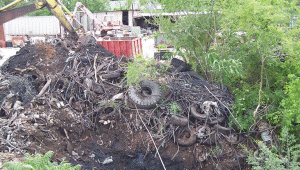Neighbors dispute contamination cause
Published 5:15 pm Wednesday, September 8, 2010

Benny Davis of Recycling Unlimited watches as contractors for the Alabama Department of Environmental Management work to clean up alleged contamination in the right-of-way property near his business. (Reporter Photo/Jon Goering)
By JAN GRIFFEY/Editor
COLUMBIANA — Clean up and soil testing is under way on a portion of state right-of-way property along Shelby County 25 in Columbiana.
Scott Hughes, a spokesman for the Alabama Department of Environmental Management, said Alabama Department of Transportation workers were doing some right-of-way maintenance and came across an area that was giving off some kind of fumes.
“They pulled back and covered it back up and we did some preliminary screening, which showed the soil contained some high levels of certain metals, lead being one of those,” Hughes said.
The contaminated area is located next to Recycling Unlimited, owned by Benny Davis.

Rob McLeroy said he uncovered trash and rubbish dumped on his property when making improvements a couple of years ago. (Contributed/Rob McLeroy)
Davis’ neighbor is Eagle Construction, owned by Rob McLeroy.
McLeroy claims Davis’ business activities have damaged and contaminated his property, as well as Davis’ property and the ALDOT right of way.
Davis said he has owned his property for 35 years and that those claims are nonsense.
“I take in only scrap metal now,” Davis said. He’s taken up a position on his property and said he will witness every moment of the ADEM clean up effort. He said he has hired a firm to do testing of the soil, as well.
“I used to take in plastic and tires, but when the state decided it wanted to start charging a fee on tires, I made a deal with the attorney general and grandfathered in the tires that were already here and I quit recycling tires. I used to cut them up and make stuff out of them, but I don’t do that anymore. Although, I do broker stuff, too.”
Davis said he has not dumped anything on property that he does not own.
“I bought this property 35 years ago. He (McLeroy) thinks it’s his property, but it’s not. I had it staked out and what I’ve dumped is on my property,” Davis said. “We’re in court over that right now.”
McLeroy said he has taken legal action against Davis, who he claims has dumped trash and rubbish on his property.
A couple of years ago, McLeroy wanted to make some improvements to his property. He began digging, hoping to find the end of a pipe that extended out into the right-of-way property.
What he uncovered, McLeroy said, was startling.
“We dug up all kinds of unbelievable looking things,” he said. “There’s no doubt they are going to find stuff,” when tests are completed.
Preliminary testing at the site, McLeroy said, showed high levels of lead, PCBs, chromium, arsenic and mercury.
McLeroy’s lawsuit against Davis dates back to May 2006, he said. The issue remains unsettled, he said.
ADEM’s Hughes said, while preliminary setting of the soil in the right of way took place more than a year ago, it took until recently to come up with the funds to clean up and do more testing in the area.
“We discussed it with the EPA and sought federal funding for the site, but it didn’t rank high enough to be immediately eligible for clean up,” he said.
Instead, ADEM found clean up money from the Alabama Hazardous Substance Clean Up Fund.
“We typically use that fund when we find an abandoned drum on the side of the road or in a warehouse that we don’t know who owns,” Hughes said. “We determined that would be the best mechanism to move forward with remediation at the site. If we can go back and find a responsible party, we can try to recover the costs. But our immediate goal is to excavate the soil and do some intense monitoring and sampling, to get all of the contaminated soil dug up and moved and properly disposed.”
Samples of soil surrounding the area will be tested in an effort to find out how widespread the contamination in the area is.
“If it comes back clean, that’s a good indication all the contaminated material will have been removed. If it still shows high levels of those metals, we will have to go back in and expand the excavation,” Hughes said.
Right now, excavation is limited to the state-owned right-of-way property. However, testing could show that clean up on private property surrounding the site is necessary.
Hughes said the project is designed to take about 10 days in total to complete, and he expects to have preliminary results of within that amount of time.
“I think they have contracted with a lab and plans for an expedited turnaround on the samples. The initial forecast is that we can get this addressed, soil excavated and backfilled with clean material in about 10 days,” he said.
“Through that effort, if we determine if the contamination extends onto that private property, we will look at that to see what the next step should be to access that private property and look at additional remediation efforts,” Hughes said.









